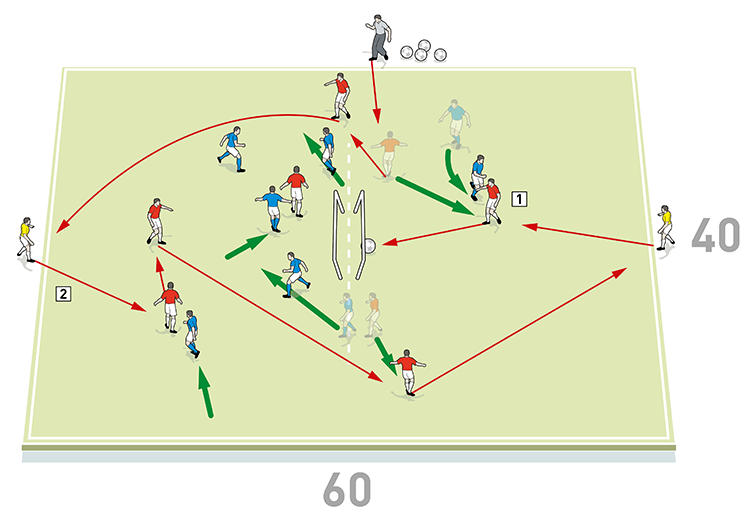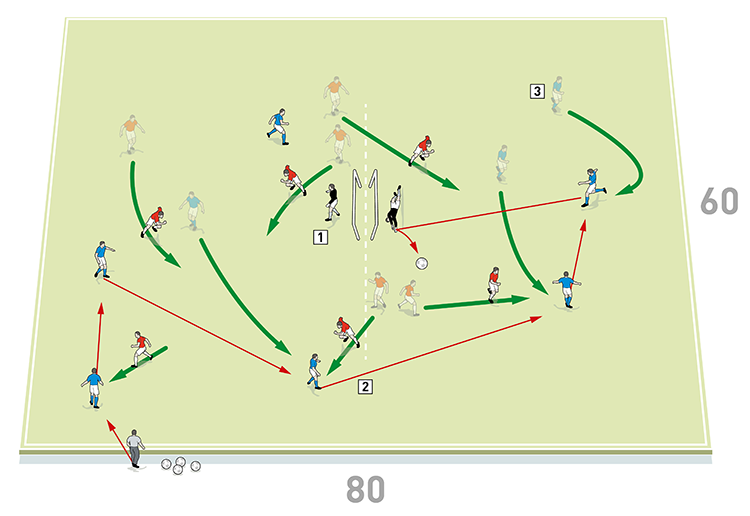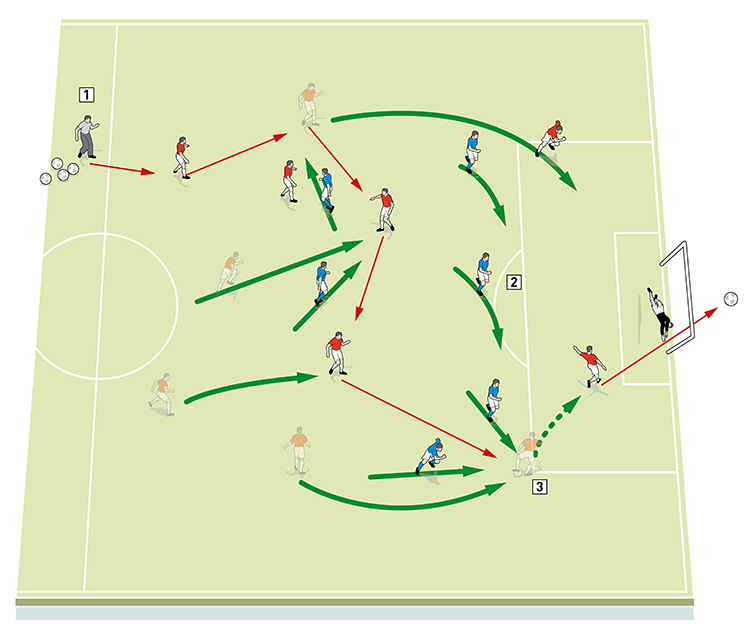You are viewing 1 of your 1 free articles
Scoring against a low block
This is a possession practice to help players develop an understanding of the concepts of how to create and use space, particularly how to create 1v1 and 2v1 opportunities in orders to score when playing against a low block.
| Area | Up to half a pitch |
| Equipment | Balls, bibs, cones, 2 small goals, 2 full size goals |
| No. of Players | Up to 14 players + 2 goalkeepers |
| Session Time | Back to back goals: 20mins, Progression: 20mins, Half pitch practice: 20mins |
This is a possession practice to help players develop an understanding of the concepts of how to create and use space, particularly how to create 1v1 and 2v1 opportunities in orders to score when playing against a low block.
This is a popular session because essentially it is a small-sided game, which makes it highly competitive and challenging for the players. It tests both technique and physical ability, but the main focus of the session is to develop decision making so players will understand when and how to create opportunities to score when facing a low block.
This session has all the principles and concepts of our play, so we will run it once a week. It can be adapted depending on whether we’re preparing to play against a low block, or a team with four or five at the back.
What do I get the players to do?
Back to back goals
We set up an area of 60x40 yards with two small goals positioned back to back in the centre. Player numbers can vary depending on our needs, but here we’re using 14 outfield players, split into two teams of six, plus two neutral players who are positioned at either end of the pitch.
The two teams attack and defend both goals and they can score in either goal. The neutral players at each end of the pitch play for the team in possession and can be used to help teams switch the play between the two goals, as shown [1].
1

2. The neutral players at each end play for the team in possession. They can be used to help switch the play between the two goals
We play four blocks of four minutes with one minute’s rest between each block.
How do I progress the activity?
Progression
To progress the activity, we swap the small goals for two full size goals and we add two goalkeepers. We increase the size of the playing area to 80x60 yards. We also take away the end players, to make it more difficult for teams to switch the play. Once the end players have been taken away, the players without the ball on the possession team have to make decisions on their positioning and find the spaces to attack, as shown [2].
2

2. The reds and the blues are attacking and defending both goals and they can score in either. Here the blues are under pressure and switch the play to attack the other goal
3. To make it more difficult to switch play, remove the end players. This challenges the possession team to find spaces to attack. Here the blue player uses clever movement to receive the ball in space and shoots
How would you put this into a game situation?
Half pitch practice
We set up on half a pitch with a goal and a goalkeeper at just one end.
We’re using 12 outfield players, split into two teams of six and we set up the defending team in a low blocking shape. The attacking team is fed the ball by the coach from behind the halfway line and they attack the low block defence, as shown [3]. We encourage the players to use the same concepts and principles learnt in the previous activities.
3

2. The blue defending team is set up in a low blocking shape. If they win the ball, defenders should clear it out of the area or play it back to the coach
3. The attacking team takes on the low block defence by creating the space to attack with a 1v1 or a 2v1 in the final third
To progress the game, we instruct the possession team to play in shape.
What are the key things to look out for?
Passing and receiving skills are the main technical aspects of the practice, but we also want to see players show an awareness of body shape and a recognition of what spaces they can play into when facing a low block.
Tactically, it’s important that players know how to create space when the opposing team is sitting deep. They should show they know how and when to play between the opposition’s defensive lines and how to create 1v1s and 2v1s in the final third.
What are the typical mistakes players might make and how do I avoid them?
The main area of focus when we look at our players’ decision making is when to play it simple and keep moving the ball, and when to attack the opposition by playing between the lines or switching the play. The players’ decision making is challenged as the opposition are controlling the space and restricting attacking options.
Related Files
Editor's Picks
Deep runs in the final third
Using the goalkeeper in build-up play
Pressing principles
Intensive boxes drill with goals
Penetrating the final third
Creating and finishing
My philosophy
Pressing initiation
Compact team movement
Coaches' Testimonials

Alan Pardew

Arsène Wenger

Brendan Rodgers

Carlos Carvalhal

José Mourinho

Jürgen Klopp

Pep Guardiola

Roy Hodgson

Sir Alex Ferguson

Steven Gerrard
Coaches' Testimonials

Gerald Kearney, Downtown Las Vegas Soccer Club

Paul Butler, Florida, USA

Rick Shields, Springboro, USA

Tony Green, Pierrefonds Titans, Quebec, Canada
Join the world's leading coaches and managers and discover for yourself one of the best kept secrets in coaching. No other training tool on the planet is written or read by the calibre of names you’ll find in Elite Soccer.
In a recent survey 92% of subscribers said Elite Soccer makes them more confident, 89% said it makes them a more effective coach and 91% said it makes them more inspired.
Get Monthly Inspiration
All the latest techniques and approaches
Since 2010 Elite Soccer has given subscribers exclusive insight into the training ground practices of the world’s best coaches. Published in partnership with the League Managers Association we have unparalleled access to the leading lights in the English leagues, as well as a host of international managers.
Elite Soccer exclusively features sessions written by the coaches themselves. There are no observed sessions and no sessions “in the style of”, just first-hand advice delivered direct to you from the coach.









